#American's DNA
Explore tagged Tumblr posts
Text
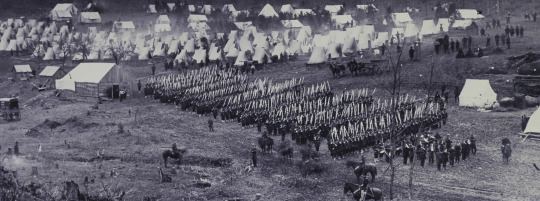
LETTERS FROM AN AMERICAN
April 12, 2024
HEATHER COX RICHARDSON
APR 13, 2024
At 4:30 a.m. on April 12, 1861, Confederate forces fired on Fort Sumter, a federal fort built on an artificial island in Charleston Harbor.
Attacking the fort seemed a logical outcome of events that had been in play for at least four months. On December 20, 1860, as soon as it was clear Abraham Lincoln had won the 1860 presidential election, South Carolina lawmakers had taken their state out of the Union. “The whole town [of Charleston] was in an uproar,” Elizabeth Allston recalled. “Parades, shouting, firecrackers, bells ringing, cannon on the forts booming, flags waving, and excited people thronging the streets.”
Mississippi had followed suit on January 9, 1861; Florida on January 10; Alabama on January 11; Georgia on January 19; Louisiana on January 26; and Texas on February 1. By the time Lincoln took the oath of office on March 4, 1861, seven southern states had left the Union and formed their own provisional government that protected human enslavement.
Their move had come because the elite enslavers who controlled those southern states believed that Lincoln’s election to the presidency in 1860 itself marked the end of their way of life. Badly outnumbered by the northerners who insisted that the West must be reserved for free men, southern elites were afraid that northerners would bottle up enslavement in the South and gradually whittle away at it. Those boundaries would mean that white southerners would soon be outnumbered by the Black Americans they enslaved, putting not only their economy but also their very lives at risk.
To defend their system, elite southern enslavers rewrote American democracy. They insisted that the government of the United States of America envisioned by the Founders who wrote the Declaration of Independence had a fatal flaw: it declared that all men were created equal. In contrast, the southern enslavers were openly embracing the reality that some people were better than others and had the right to rule.
They looked around at their great wealth—the European masters hanging in their parlors, the fine dresses in which they clothed their wives and daughters, and the imported olive oil on their tables—and concluded they were the ones who had figured out the true plan for human society. As South Carolina senator James Henry Hammond explained to his colleagues in March 1858, the “harmonious…and prosperous” system of the South worked precisely because a few wealthy men ruled over a larger class with “a low order of intellect and but little skill.” Hammond dismissed “as ridiculously absurd” the idea that “all men are born equal.”
On March 21, 1861, Georgia’s Alexander Stephens, the newly-elected vice president of the Confederacy, explained to a crowd that the Confederate government rested on the “great truth” that the Black man “is not equal to the white man; that…subordination to the superior race is his natural and normal condition.” Stephens told listeners that the Confederate government “is the first, in the history of the world, based upon this great physical, philosophical, and moral truth.”
Not every white southerner thought secession from the United States was a good idea. Especially as the winter wore into spring and Lincoln made no effort to attack the South, conservative leaders urged their hot-headed neighbors to slow down. But for decades, southerners had marinated in rhetoric about their strength and independence from the federal government, and as Senator Judah P. Benjamin of Louisiana later wrote, “[t]he prudent and conservative men South,” were not “able to stem the wild torrent of passion which is carrying everything before it…. It is a revolution...of the most intense character…and it can no more be checked by human effort, for the time, than a prairie fire by a gardener’s watering pot.”
Southern white elites celebrated the idea of a new nation, one they dominated, convinced that the despised Yankees would never fight. “So far as civil war is concerned,” one Atlanta newspaper wrote in January 1861, “we have no fears of that in Atlanta.” White southerners boasted that “a lady’s thimble will hold all the blood that will be shed” in establishing a new nation. Senator James Chesnut of South Carolina went so far as to vow that he would drink all the blood shed as a consequence of southern secession.
Chesnut’s promise misread the situation. Northerners recognized that if Americans accepted the principle that some men were better than others, and permitted southern Democrats to spread that principle by destroying the United States, they had lost democracy. "I should like to know, if taking this old Declaration of Independence, which declares that all men are equal upon principle, and making exceptions to it, where will it stop?” Lincoln had asked in 1858.
Northerners rejected the white southerners’ radical attempt to destroy the principles of the Declaration of Independence. They understood that it was not just Black rights at stake. Arguments like that of Stephens, that some men were better than others, “are the arguments that kings have made for enslaving the people in all ages of the world,” Lincoln said. “You will find that all the arguments in favor of king-craft were of this class; they always bestrode the necks of the people, not that they wanted to do it, but because the people were better off for being ridden…. Turn in whatever way you will—whether it come from the mouth of a King, an excuse for enslaving the people of his country, or from the mouth of men of one race as a reason for enslaving the men of another race, it is all the same old serpent….”
Northerners rejected the slaveholders’ unequal view of the world, seeing it as a radical reworking of the nation’s founding principles. After the Confederates fired on Fort Sumter, Lincoln called for 75,000 to put down the rebellion against the government. He called for “loyal citizens to favor, facilitate, and aid this effort to maintain the honor, the integrity, and the existence of our National Union, and the perpetuity of popular government; and to redress wrongs already long enough endured.”
Like their southern counterparts, northerners also dismissed the idea that a civil war would be bloody. They were so convinced that a single battle would bring southerners to their senses that inhabitants of Washington, D.C., as well as congressmen and their wives packed picnics and took carriages out to Manassas, Virginia, to watch the Battle of Bull Run in July 1861. They decamped in panic as the battle turned against the United States army and soldiers bolted past them, flinging haversacks and rifles as they fled.
For their part, southerners were as shocked by the battle as the people of the North were. “Never have I conceived,” one South Carolina soldier wrote, “of such a continuous, rushing hailstorm of shot, shell, and musketry as fell around and among us for hours together. We who escaped are constantly wondering how we could possibly have come out of the action alive.”
Over the next four years, the Civil War would take more than 620,000 lives and cost the United States more than $5 billion. By 1865, two-thirds of the assessed value of southern wealth had evaporated; two-fifths of the livestock— horses and draft animals for tilling fields as well as pigs and sheep for food— were dead. Over half the region's farm machinery had been destroyed, most factories were burned, and railroads were gone, either destroyed or worn out. But by the end of the conflagration, the institution of human enslavement as the central labor system for the American South was destroyed.
On March 4, 1865, when a weary Lincoln took the oath of office for a second time, he reviewed the war’s history. “To strengthen, perpetuate and extend [slavery] was the object for which the insurgents would rend the Union even by war while the government claimed no right to do more than to restrict the territorial enlargement of it,” he said. “Neither party expected for the war the magnitude or the duration which it has already attained. Neither anticipated that the cause of the conflict might cease with or even before the conflict itself should cease. Each looked for an easier triumph and a result less fundamental and astounding.
“Both read the same Bible and pray to the same God and each invokes His aid against the other. It may seem strange that any men should dare to ask a just God’s assistance in wringing their bread from the sweat of other men’s faces but let us judge not that we be not judged. The prayers of both could not be answered—that of neither has been answered fully. The Almighty has His own purposes.”
“Both parties deprecated war but one of them would make war rather than let the nation survive, and the other would accept war rather than let it perish,” he said.
“And the war came.”
LETTERS FROM AN AMERICAN
HEATHER COX RICHARDSON
#American Civil War#Heather Cox Richardson#Letters From Am American#racism#created equal#equality#Fort Sumpter#The South#income inequality#American's DNA
19 notes
·
View notes
Text

Walter Velez (1939-2018), ''Future Life'', #25, March 1981 Source
169 notes
·
View notes
Text
Did you know Ghana has a law allowing descendants of enslaved Africans to return and gain citizenship? Passed in 2001, it’s still unknown to many in the diaspora. This video explains everything:
✔️ What Ghana’s Right of Return is.
✔️ How the process works: DNA proof, residency, and cultural engagement.
✔️ Benefits of citizenship, like owning land and full integration into society.
✔️ The Year of Return in 2019, marking 400 years since the first enslaved Africans were taken to Virginia in 1619.
Ghana’s efforts have inspired similar movements across Africa, making it a key destination for reconnecting with your heritage. Learn how you can be part of this life-changing opportunity.
@_the_merc
#black people#ghana#black diaspora#majority african dna#africa#african repatriation#back to africa#african#african american#african history#african citizen#citizenship#dna
18 notes
·
View notes
Text
Tonight the state of Missouri killed Marcellus Williams.
The nation cried out for his life and we were ignored.
The family of Felicia Picus (the woman he was accused of murdering) asked for a stay of execution. They will never see justice for their loss.
The prosecutor asked for a stay.
But it did nothing.
Governor Mike Parson refused to save Marcellus' life.
The Supreme Court refused to save Marcellus' life.
Marcellus Williams was killed for a crime he did not commit.
Marcellus "Khaliifah" Williams was a Black, Muslim man and he was murdered by a system which was never meant to protect him.
Marcellus is a victim of the unjust justice system of this country.
Say his name.
#marcellus williams#innocence project#wrongful imprisonment#black lives matter#May he rest easy in the highest levels of Jannah#The mishandling of evidence and DNA which eliminated Marcellus as a potential culprit makes this an act of violence by the state#black americans make up 13% of the nation's population and yet are 37% of the incarcerated population#this is may be impacted by the lack of resources given to predominantly black areas but it is most definitely impacted by racism in legal-#-spaces#anti blackness#missouri#missouri had 200 sun down towns#missouri news
34 notes
·
View notes
Text
Okay American Arcadia fans, you asked for it! Some girl having her life destroyed by a 23 and Me DNA test dare, running for her life with her ancestor’s talking head, and finally punching an imposter in the face on LIVE TV. YOU’RE WELCOME!

Picture inspired by a scene in Stray Gods.
#american arcadia#american arcadia spoilers#american arcadia oc#oc#sketch dump#vivian walton#for now I’m calling this oc Willow Malton#might change her design if I make more of this idea on the side#DNA Testing ruining lives and companies everywhere#stray gods inspired
52 notes
·
View notes
Note
As an Irish person, I just wanted to offer a smidgeon of context about gatekeeping.
First of all, you are completely correct that anyone is free to have an informed opinion about Irish history, or any history. It's welcome, even, since those who do not learn and all that. I didn't want to come off like I was contesting that point. I've got strong opinions about colonial history all over the place.
The thing that really annoys us, especially on the Irish left, is what we call 'yankee blood magic'. USAmericans who have ignorant but strong opinions of Irish history or contemporary Ireland also tend to behave as though some distant blood relation matters. To us that's just racist nonsense. Cultural continuity is what defines Irishness for us, so someone claiming to be Irish despite never having set foot here and without a genuine connection to modern, living Irish culture is affrontery and usually a vehicle for bioessentialist tripe. By contrast, most of us (I will not pretend we don't have a racism problem here, implicit and insidious even without the rising far right) will adopt anyone as Irish when they've lived here for a while.
I just felt this was worth mentioning since the last anon cited descent over actual historical study. Not going to pretend this is particularly rational or good politics either, it just is how it is.
Oh yeah, I completely agree with you. I've run into quite a few of these people myself + experienced it more directly with usamericans acting similarly about scotland & I agree that they're some of the most annoying people on earth. what I was trying to say ig wrt the last ask is that to me "can I have an opinion on [topic]" is less dependent on how "connected" you feel you are to it and more about whether or not you know what you're talking abt enough to justify having an opinion; i.e. whether or not you should be having strong opinions on irish history is something almost completely unrelated to who you're biologically descended from or what % DNA you have and far more related to whether or not u can back your opinions up with anything, be that learned knowledge or genuine cultural connection. probably should have phrased it better lmao
#trying not to traumadump in the tags but man some of the conversations I've had lately w usamericans regarding dna tests 😐#they need to make dna tests more difficult to buy than automatic weapons for americans for real#jory.postbox
12 notes
·
View notes
Text
My brain always reads “Pilchard” as “Plick-urd” (because they don’t say it in the song; it took me far too long to realize the I and L are switched) so I looked it up and you really just say it exactly like it’s spelled.
Anyway, a pilchard is a fucking sardine! And apparently sardines are in the same family as herrings.
I can’t say the “I” adjective at the beginning of that song title, either. Ignominious. I just forget which letters are in it. It means “deserving or causing public disgrace or shame.”
#the mechanisms#the ignominious death of dr pilchard#ttbt#that u in my phonetic spelling of my mispronunciation of pilchard is a schwa#i am american. half my vowel sounds are schwas#my wikipedia rabbit hole went european pilchard -> Alosidae -> Alosa -> Clupeidae becauss the Alosa page has a mistake on it#p sure I worked with Alosa dna for my job
45 notes
·
View notes
Text
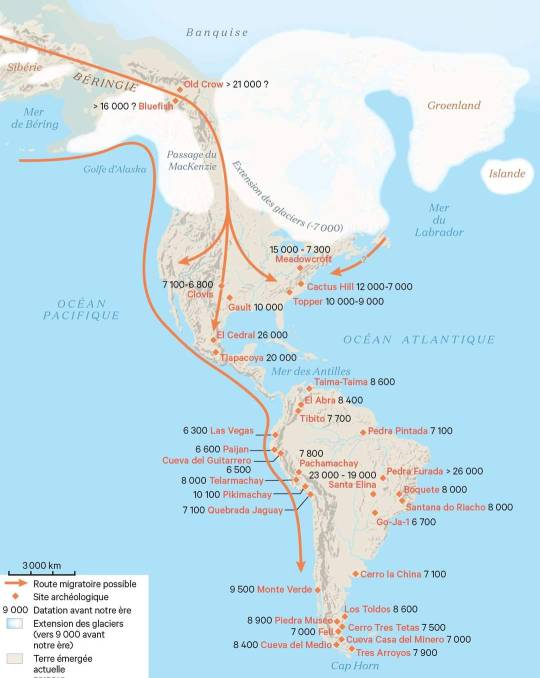

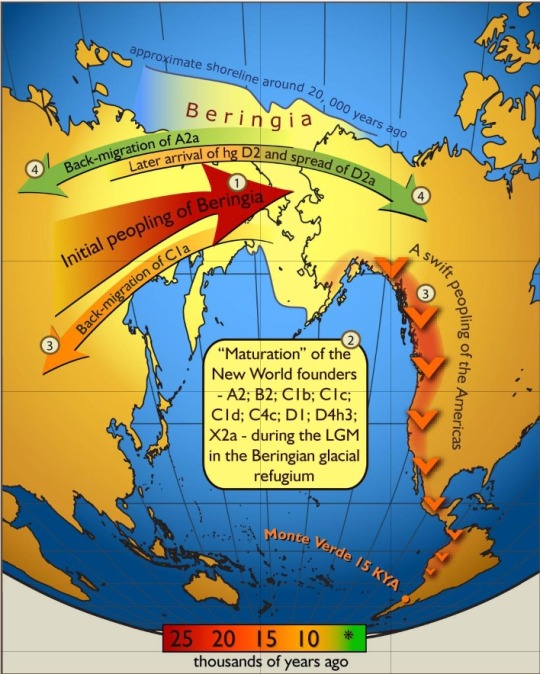
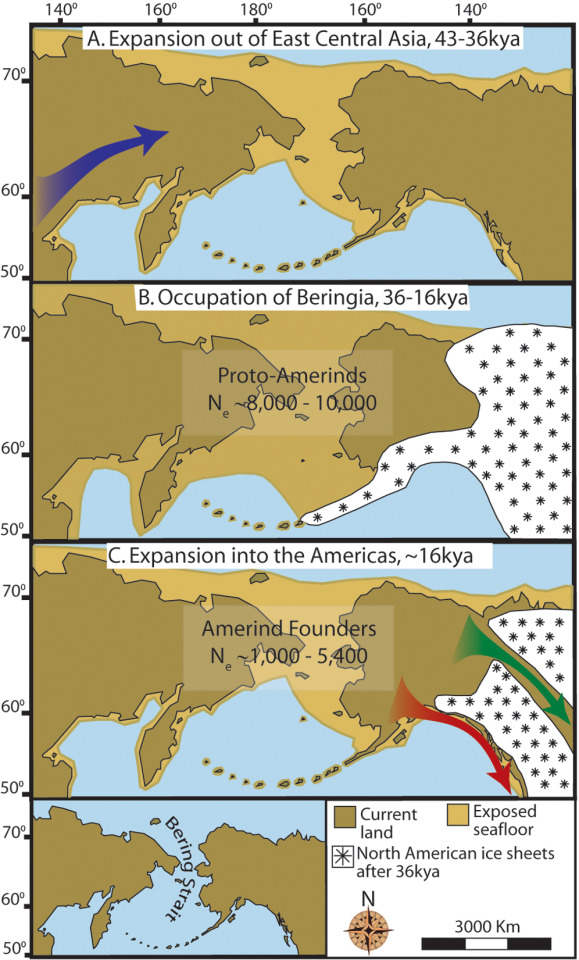
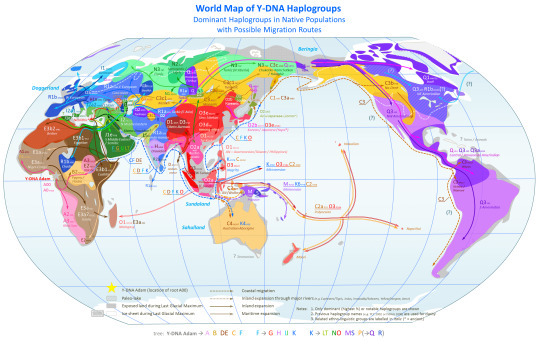
Some maps showing the probable peopling of the Americas.
#paleoanthropology#archaeology#first peoples#native american#beringia#nivkh#dna#haplogroups#meadowcroft
14 notes
·
View notes
Text
food is love
Everything I learned how to cook or bake is a spiraling tattoo of those I have loved or love. Those here and gone. Every learned skill or recipe is a love letter of a sort.
I learned how to cook from my mother. I make marinara sauce from scratch and meatballs, and when I do, it reminds me of her. Of a kitchen that smelled of garlic cooking in olive oil, of sauce that simmered all day.
Growing up, holidays were all about food and togetherness, so I carry on those traditions for my dad and two siblings. Christmas Eve is always seven different kinds of fish, spaghetti, and antipasto. It's all a roadmap, a history.
I learned how to make jalapeno ramen, because of a restaurant in Montreal that @lizleeillustration took me to. I learned how to make gumbo, from scratch, after living in the south. Every time I make it, I think of my friends there.
I make hot chocolate the way a childhood friend did. I taught myself how to make my grandmother's Italian cheesecake from barely half a recipe and years of experience. It didn't even have a pan size. Ingredients were missing. Those that were present were written as a little bit of milk or a can of ricotta. Ricotta, it should be noted, doesn't come in a can. At least, not as long as I've been alive.
But I perfected that recipe for my dad, by request, for his birthday. Because to me, food is love. And I love taking care of people. That's honestly one of the truest things about me. And I will learn how to make your favorite dish. And I have absolutely delighted in cooking for friends, and you can absolutely summon me for a weekend, if there's coffee and a couch. Because to me, the best times really aren't fancy dinners (which I love), but cozy bits of stolen time with good food and conversation. I love the intimacy of a shared meal and a bottle of wine. I often joke that I am a kitchen witch, but at this point, I genuinely mean it.
There's magick in a good meal, whether it's a winter stew or a lasanga or baked fish. I love the smell of a meal as it's progressing. The way it warms the room and the heart. I love the chaos of it, too, the timing, the feeling of getting it right. The dog being underfoot just hoping for an error.
Recently, I made meals for my best friend, who had several surgeries. For her, I taught myself how to make white chicken spinach lasagna with bechamel. And by taught, I mean found a recipe, realized I could make it better, and now I have a brilliant new meal in my rotation. I can't make the surgeries easier, but food? Food I can do.
I think good food eases a broken heart. I think good food conjures love. I think a shared meal and a long walk are two of the best joys in life, and you won't ever convince me otherwise.
If we are friends, chances are I will try to feed you. That's who I am. It's also how I show affection or care, whether it's platonic or romantic. Because love in its myriad forms means food, more than occasionally in the form of baked goods. And now that's it's turning toward winter, baked goods can easily be shipped. So, maybe I'm plotting.
And I do take requests.
#cooking#baking#food is love#food tells a story#history#truth#sharing a meal#I will feed you#it's in my DNA#Italian American#Traditions#affection#care
20 notes
·
View notes
Note
Just curious, where would you recommend starting genealogy research? I’m mostly curious more than anything, thought I don’t think having Native American lineage is likely for me?
Start by talking to your family and writing down as much info as you can. Names of grandparents, great grandparents, aunts, uncles, whatever you can. Birth dates and places they lived as well.
I do genealogy thru ancestry.com and it's mostly great but I know some people have problems with it. You can get a 2 week free trial and you might be able to get plenty of your tree filled out in that time.
Then, just put in what info you got from your parents, and look for census records. US Census records from 1950 and earlier are public, so start there. I was able to go back to my gg grandfather just thru censuses, and then I was able to find his Dawes card. I have gone back further but the farther back it goes the less reliable anything is. Be wary of anything on ancestry or other sites where the only source is someone else's tree, because people can put whatever they want down and a lot of it is wrong. [For example, on other parts of my tree it's tried to connect me to pocahontas 3 times.]
Ofc this advice doesn't just apply for those looking for native ancestry, it's just general genealogy stuff and it's really interesting for anyone to learn about their ancestors (:
Sorry this might be specific to the US, I'm not familiar with how records work elsewhere.
Good luck!
#asks#id advise against the dna test mostly. its really just a novelty#and its only actual use is in the case of adopted people who can connect to bio family. or otherwise to connect to cousins and such#the dna makeup thing is just a novelty.#specifically for native stuff. dna cannot prove tribal ties at all. genealogy is the only.way to do that#as in the dna test cant tell you youre cherokee. it might say indigenous americas north but not cherokee#also there are many many cases where dna shows native american traces with absolutely no proof of that in the genealogy#which just shows that it kinda guesses#or in some cases people [hello] can have genealogical proof of native ancestry#but have none show up on a dna test. so it cant prove one way or the other#and im kinda tired of people bringing ot up to say 'see they arent native the dna test showed that' when that isnt actually proof#stop trying to legitimize dna when it comes to tribal identity. its entirely not relevant.#reconnecting#i know this isnt specifically native reconnecting but maybe the genealogy info makes it good to have in the tag
7 notes
·
View notes
Text
This lady that Vincenzo is trying to get to be an expert witness asks him if he likes opera.
Ma'am, he is literally Italian.
#ashleybenlove posts#Vincenzo#season 1#Episode 7 (Vincenzo)#I mean yes ethnically he is Korean but all the Korean characters refer to him as Italian#I'm around 50 percent German ethnically but I'm sure if I went to Germany they'd just call me American#my DNA hasn't been in Germany since the 1800s
4 notes
·
View notes
Note
Did you hear about the Pilar barbie situation on TikTok where it was a white women lying about being Romani and created a whole make-up business off the lie 😭
GIRL omg 💀💀 gossiping about Pilar is one of my favourite activities...
She has a lot of lore so I'm going to walk you through all I can remember
For the people who don't know her, Pilar was an American tiktoker who made videos about Romani issues (this is the only remaining picture of her I found on tiktok)

From what I remember, she was already there in 2020 during COVID times when I became active on Romani internet. I don't even remember when she got really popular, it must have happened gradually or something but she was one of the biggest Romani 'internet activists' alongside Florian and Brooke (in the early days).
Sometimes she also dressed more 'traditional'

which... really just looks like she was putting on a costume. anyway I don't have more recent pictures from her tiktoks as she suspended her account but the way she wore a headscarf and golden jewellery to try and emulate being Romani was already pretty messed up and unnecessary, as a lot of Romani women dont wear either of these things in the first place
I don't remember what group she was originally claiming to be from, but that's the point, she kept changing it. Except that she did so over a very slow period of time and by making only vague references about her heritage so it was hard to catch on. Anyway, over the past 4 years I have heard her say she was:
Russian Romani
Polish Romani
Crimean Romani
Gitana/Spanish Romani
Sinti
Manush, to be even more specific
Mixed Eastern European Romani + Manush
And that is all I specifically remember but I wouldn't be surprised if she also had a kalderash or lovari arc at some point 💀 anyway, after a while I started noticing things weren't adding up and her heritage was very vague and that was weird. Not to be mean, but she is also American, and I always feel way, way more cautious when it comes to American Roma than European Roma, Romani racefakers are almost always American because no European in their right mind would think it's cool to pretend to be romani 😭😭
Anyway, what really made it for me was the stuff she used to say on tiktok. Some of it was just blatantly not true. I almost lost my mind during her Sinti arc because she said stuff like "Sara e Kali isn't a big religious figure for Sinti people", "Sara e Kali isn't a catholic romani figure", and then she also pretended to have ties to some famous Sinti people when i know for a fact that is not possible... But I can't say more about that because that would be too doxx-y... She also said some more bs about Sinti people and I corrected her in the comments and she tried to follow me and it was so cringe
Then I also knew she was toxic because she would harass Romani women on tiktok and I remember at least one instance when she insulted a European Romani woman by saying, "you claim to be Romani but you dress like a hoe, you're just a gadji because Romani women respect ourselves by covering up"....
Two other things that didn't sit right with me was her clntent. She would talk a lot about anti Roma racism in Europe, which was great, she would talk about news no one else talked about. But she had a very guilt-trippy and angry way to talk about it that made it look like she was overdoing it and mocking the way antiracist activists talk, just to get engagement. It didn't feel genuine. And also, she would put ads for her make up brand and Cosplays of her as Wanda Maximoff between tiktoks about pogroms and police brutality. It all looked like a scam and like she was doing some traumaporn just for people to buy her stuff
And she also bullied Brooke so hard that she never came back on Tiktok, even though she (Brooke) had been the OG Romani tiktoker, had even been featured in Romea (a Romani newspaper), and was genuinely half Romani. And why? Because she is white passing? That's stupid, Pilar was allegedly white passing herself
(the way so many Romani tiktokers turned their back against Brooke was super disgusting btw, I don't know her personally but from what I've heard she is a very nice person)
Anyway, by 2022 I knew for sure Pilar was lying. That year I got in touch with other Romani girls and women online and we discussed it and they also all knew that Pilat was lying. Her being a racefaker was pretty much an open secret, at least among (chronically) online Romani people. Except that none of us could call her out, because she was very popular and extremely toxic. I can't even tell you how toxic she was. She had a circle made up of other American Romani women and they bullied tons of Romani people online, and guess what these romani people had in common!
Most of them were women
Most of them had a complicated family history
A lot of them were white passing (really tho, being white passing seems to be a problem ONLY when you are a woman. white passing Romani men never receive any hate)
A lot of them were LGB
And these American Roma bullied them, made a lot of them suicidal (seriously, I've heard several accounts of Pilar's bullying victims becoming suicidal), because they allegedly weren't 'romani enough'.
So, obviously, neither me nor any of my friend could call her out because we weren't nowhere as popular and we were all LGB romnia.
But then came FLORIAN. Literally the only person who could put a stop to her shenanigans. Ngl, I think only Florian, a straight, American Romani man with a big platform could have stopped her. And I am so glad he did, because she really made being Romani on the internet very stressful. I was so scared she would come to Tumblr one day lmao. Anyway, I have a lot of bones to pick with Florian but that was his biggest W. Here is his tiktok btw:
#Everything about her was faaake omg#when Florian's tiktok call out dropped I screamed#the evil is defeated etc#So ironic that those bullies were AMERICAN too...#American Roma don't get an iota of the racism Sinti and Roma face in Europe#but they still have the nerve to pretend they can say who is Roma and who isn't??#also her Romaness accent was so bad#And I remember when her DNA test leaked and her family tree was all Spanish people lmao#but she got that account suspended#asks#Anon#Pilar
8 notes
·
View notes
Text


Remember to join us at The Afro-American Historical and Genealogical Society, Inc. (AAHGS) 45th National Conference. Two sessions tomorrow, starting at 1:30PM Eastern, will reveal how to mine genealogical gems from your genes, separate fact from fiction, and discern science from pseudoscience. See you soon.
#genealogy#genetic genealogy#dna#genetics#african american genealogy#conferences#events and conferences#autosomal dna#x chromosome
2 notes
·
View notes
Link
61 notes
·
View notes
Text
Bigfoot DNA Evidence
Tradition claims that Bigfoot, also known as the sasquatch, is a legendary creature that inhabits the forests of North America. For decades, witnesses have reported seeing a big, hairy, ape-like entity. These sightings have persisted, and witnesses have described the creature. The investigation of whether or not Bigfoot exists has resulted in a significant number of attempts to collect physical evidence, with DNA analysis being the primary focus of these efforts. Researchers have gathered a variety of samples believed to be associated with Bigfoot. These samples include hair, skin, blood, and even feces. Reports of sightings in distant regions have led to the frequent discovery of these samples in those areas. We hope that DNA analysis will yield tangible evidence of an unidentified species.

However, researchers have recognized a significant number of samples as belonging to common animals like dogs, bears, and deer. In a particularly noteworthy instance, researchers discovered that a hair sample believed to belong to Bigfoot actually originated from a bear. This exemplifies the challenges that arise when attempting to differentiate between biological elements that appear to be similar in appearance in the wild. Furthermore, the degradation of some samples renders them incapable of yielding valid results, thereby complicating the process of drawing conclusive results. In many instances, researchers have asserted that they have discovered DNA sequences that do not correspond to any known species. This has caused Bigfoot aficionados to feel a sense of excitement. On the other hand, the scientific community often views these assertions with considerable suspicion. Critics question the experimental methods used and highlight potential issues with sample contamination. The lack of peer review and replication renders these findings speculative. Hoaxes and false allegations add another layer of complexity to the search for Bigfoot. Research has demonstrated that some individuals have manipulated evidence, like fabricated footprints and altered DNA samples, to attract media attention or boost their financial status. Taking these actions undermines legitimate scientific efforts and contributes to the suspicion surrounding Bigfoot investigations.

Even though these obstacles exist, the appeal of discovering a new species continues to keep researchers and fans interested in the field. The continuous advancement of DNA sequencing and analysis technology raises the possibility of discovering additional conclusive evidence in the future. Until further notice, Bigfoot remains a fascinating mystery that inspires ongoing investigation and discussion. Scientific investigation is not the only source of interest in Bigfoot, a more widespread cultural and psychological obsession with the unexplained serves as its foundation. The concept of a mystery creature that seems to be hiding in the bush strikes a chord with our sense of curiosity and our yearning to experience new things. Whether or not we ever confirm its existence, the mythology of Bigfoot will endure as a symbol of the secrets nature still holds.
2 notes
·
View notes
Text
Today I was scrolling through Google recommended "Scottish gifts" for reasons and all these American made Scottish things are hilarious such as a bracelet called "flower of Scotland" that had a cutesy five petal flower on it and an empty jar labelled "scotch mist"
#there was this HIDEOUS “its in my dna” t-shirt that low key i wanted#i actually want an ENTIRE wardrobe dedicated to those tacky scottish-american t shirts i think it could be camp#certified yapper
2 notes
·
View notes